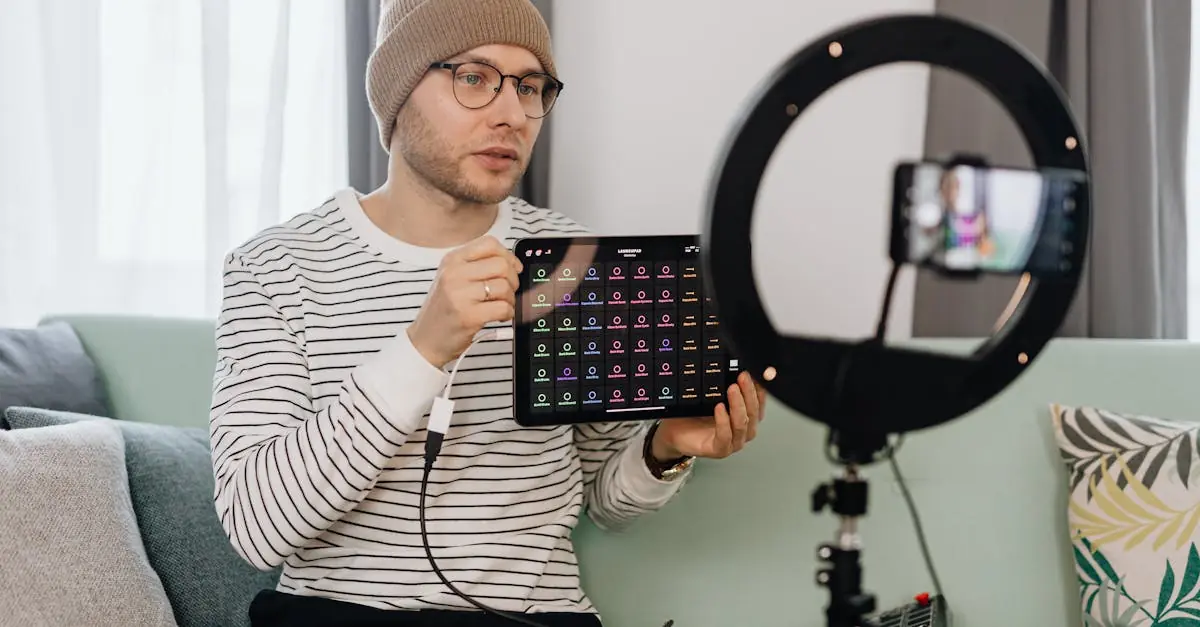In a world where coding is the new superpower, diving into the realm of programming can feel like trying to decipher hieroglyphics while riding a unicycle. Fear not! With the right coding tutorials and tips, anyone can transform from a confused newbie into a confident coder.
Table of Contents
ToggleUnderstanding Coding Tutorials
Coding tutorials offer structured guidance for beginners and experienced programmers. These resources simplify the learning process, making programming more accessible.
Types of Coding Tutorials
Interactive coding platforms provide hands-on experience through coding challenges. Video tutorials often cater to visual learners by demonstrating concepts in real time. Written guides allow for in-depth exploration of topics, providing detailed explanations and examples. Workshops and webinars facilitate live interactions with instructors, enhancing learning through direct engagement. Each type serves specific learning needs and preferences.
Benefits of Coding Tutorials
Coding tutorials enhance comprehension by breaking down complex subjects into manageable segments. They offer flexible learning options, accommodating various schedules and speeds. Many tutorials promote practical skills, allowing learners to apply concepts immediately. Community support often accompanies tutorials, fostering collaboration and motivation among peers. These resources build a strong foundation, empowering individuals to tackle increasingly challenging programming tasks.
Tips for Choosing the Right Tutorial
Choosing the right coding tutorial enhances the learning experience and streamlines the journey to becoming a proficient programmer. Consider the following tips to make an informed decision.
Assessing Your Learning Style
Determine the most effective learning style before selecting a tutorial. Visual learners often benefit from video tutorials that demonstrate concepts in real time. Auditory learners might prefer podcasts or workshops that emphasize discussions. Kinesthetic learners thrive when engaging in hands-on coding exercises such as interactive platforms. Understanding personal preferences allows individuals to select tutorials that resonate with their unique learning processes.
Checking for Up-to-Date Content
Inspect the tutorial for relevance and accuracy. Outdated tutorials can mislead learners with deprecated concepts or obsolete programming languages. Seek tutorials updated within the last year to ensure the material reflects current industry standards. Review user feedback and ratings, as they indicate how well the tutorial meets contemporary coding practices. Prioritize sources with a strong reputation for regularly refreshing their content to provide the best learning experience.
Effective Learning Strategies
Effective learning strategies help individuals navigate their coding journey successfully. Implementing specific techniques can lead to significant improvements in understanding and skills.
Setting Realistic Goals
Setting realistic goals keeps learners motivated. Short-term objectives, such as completing a specific module or understanding a coding concept, often break the process into manageable parts. Long-term goals provide direction and a sense of accomplishment as skills develop over time. Review progress regularly to adjust goals accordingly. This adaptability ensures learners remain engaged and inspired.
Practicing Regularly
Practicing regularly cements knowledge and skills in coding. Engaging in daily coding exercises enhances problem-solving abilities. Consistency is key; even short sessions provide substantial benefits. Utilizing platforms offering challenges can encourage ongoing learning and exploration. Collaboration with peers further enriches the experience, as discussing solutions fosters a deeper understanding of concepts. Regular practice transforms coding from theory into a tangible skill, leading to greater confidence and competence.
Enhancing Your Learning Experience
Engaging with others can significantly boost the coding journey. Learning from peers and experienced programmers fosters a supportive environment.
Joining Coding Communities
Joining coding communities provides opportunities for collaboration and feedback. Online forums, social media groups, and local meetups connect learners with others facing similar challenges. These platforms allow individuals to ask questions, share knowledge, and discover new coding resources. Participating in hackathons or coding competitions strengthens problem-solving skills and enhances real-world experience. Networking with other coders may lead to mentorship, opening doors to further learning and job opportunities.
Utilizing Additional Resources
Utilizing additional resources expands knowledge beyond tutorials. Books offer in-depth understanding of programming concepts, while online courses provide structured content in specific areas. Many free websites offer interactive coding challenges that reinforce learning. Webinars and podcasts introduce new trends and expert insights, enriching the coding experience. Following influential developers on social media keeps learners updated on technology advancements and best practices. Diversifying resources enhances engagement and promotes continuous improvement in coding skills.
Embarking on a coding journey can be daunting but with the right tutorials and strategies it becomes an achievable goal. By understanding individual learning styles and setting realistic objectives learners can navigate challenges effectively. Engaging with coding communities and participating in collaborative projects not only enhances skills but also builds valuable connections.
Incorporating diverse resources and staying updated with industry trends ensures continuous growth in coding expertise. With dedication and the right support anyone can transform from a novice to a proficient coder ready to tackle real-world problems.



